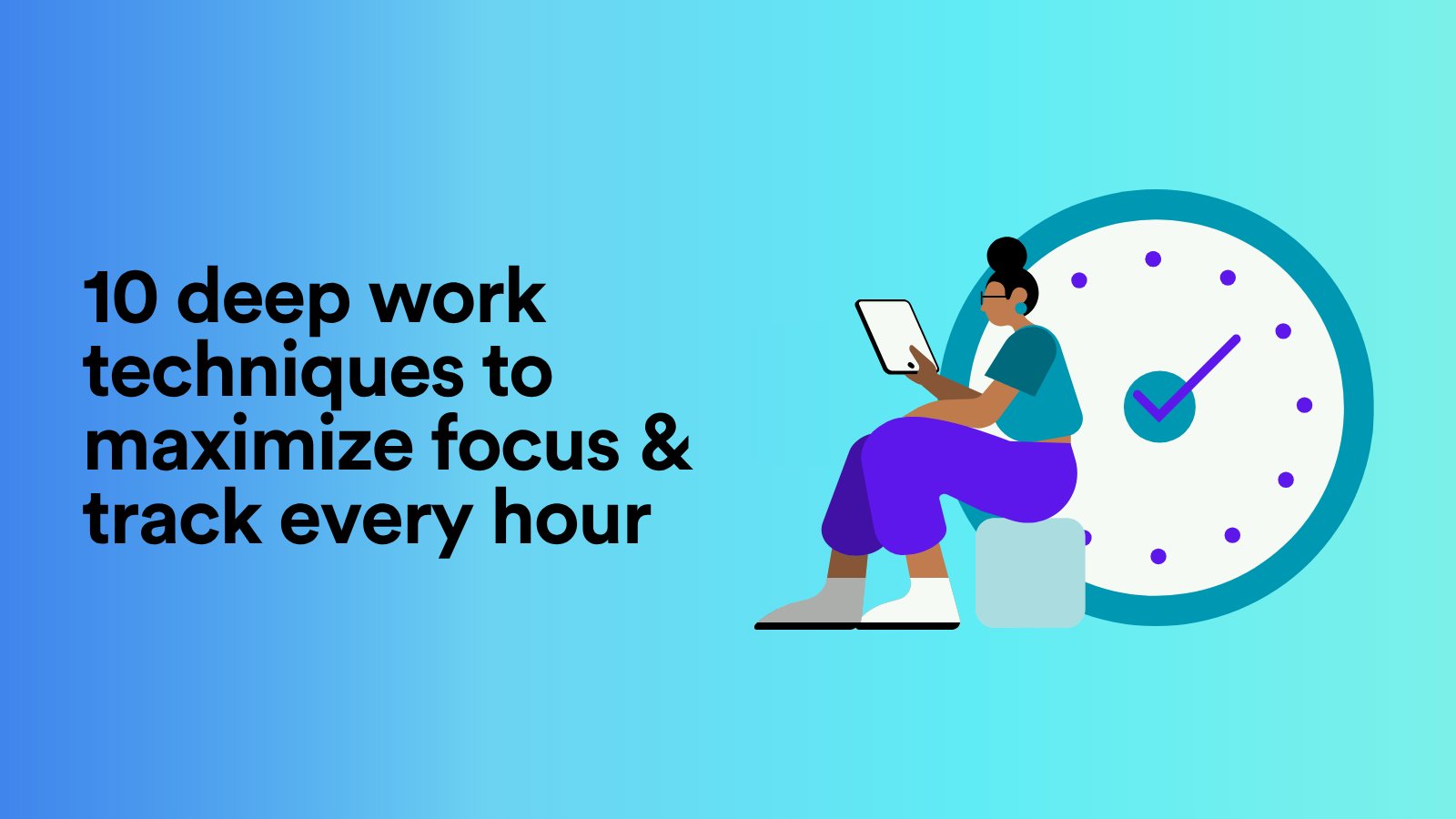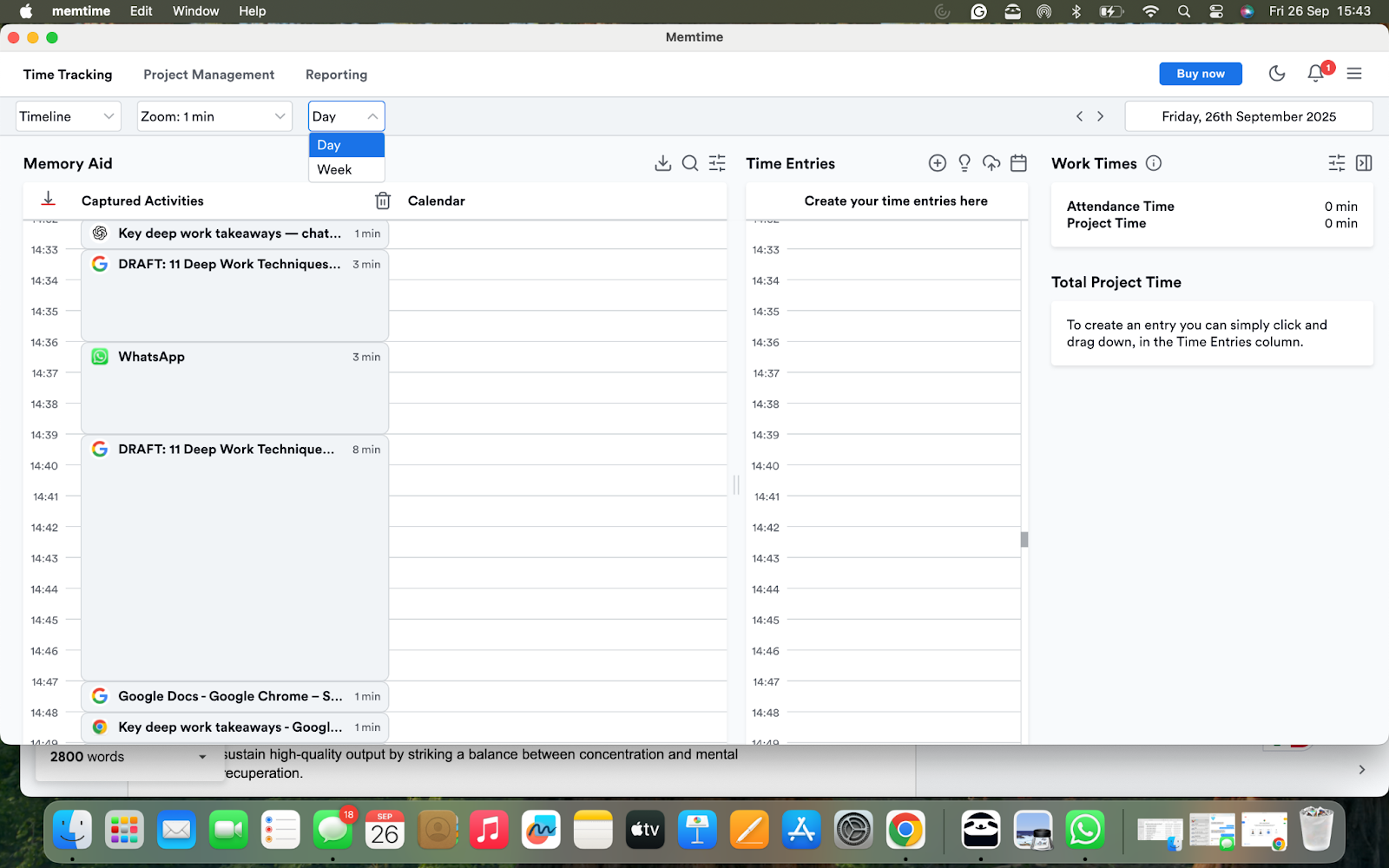10 Deep Work Techniques to Maximize Focus & Track Every Hour

In a world rife with constant pings and multitasking, deep work has become a rare superpower. The term "deep work," popularized by Cal Newport, describes concentrated, distraction-free effort that yields valuable outcomes. It's the antithesis of shallow work, which consists of scattered activities like meetings and emails that take up your day but don't really advance anything substantial.
Whether you're starting a deep work routine or are unsure of how many hours of deep work a day are reasonable, we’ll outline 10 useful deep work techniques to help you track time purposefully and increase your focus.
Don’t balk at the read time indicator on the left there. This article may be longer than usual, but it's packed full of do’s and don’ts, techniques, real-life examples, and tips on how to get your deep work tracking off the ground. In short, it’s time well spent. And, trust us, time is our business 🦸🏻♀️
Key takeaways
- Most people can maintain 1 to 4 hours of true deep work per day. Building consistency and maintaining focus each day is the true driver of success, not maximizing hours.
- It's important to get the difference between deep and shallow work. For instance, administrative and reactive tasks don't belong in deep work slots, whereas strategic, creative, or problem-solving tasks do.
- Setting time limits, triggers, and distraction-free surroundings facilitates a smoother transition into focus mode.
- Deep work becomes more sustainable when you use lead metrics (such as hours logged), visual scoreboards, and frequent reviews. Automatic trackers and other passive tools allow you to reflect without interrupting your focus.
- In addition to preventing burnout and fostering creativity, purposeful rest enables your subconscious to process difficult issues. This can result in more significant breakthroughs.

What is deep work exactly?
Deep work is the discipline of concentrating on high-value, distraction-free tasks within a specified time period. The idea, first proposed by professor and author Cal Newport, refers to a state of extreme focus that pushes your cognitive abilities. The desired result? Meaningful work that’s not readily replicated by anyone or anything.
Moreover, real progress should occur during deep work, as opposed to shallow work, which consists of routine, low-effort tasks frequently completed while you’re daydreaming about what to have for dinner.
Newport's framework outlines four scheduling philosophies. Choosing the right one can assist you in incorporating deep work into your day:
- Monastic: As inferred, this involves complete seclusion from trivial tasks or shallow work
- Bimodal: This is changing between days/weeks of deep and shallow work
- Rhythmic: Daily bursts of intense work, frequently simultaneously
- Journalistic: Focusing on opportunities whenever time permits
For example, a software engineer might adhere to the Rhythmic model, coding extensively from 8 am to 10 am every day, while a freelance editor fielding impromptu calls might use the Journalistic model to write in between meetings.
What is the optimal number of hours per day for deep work? According to Newport, depending on experience and mental capacity, most people can maintain 1 to 4 hours of true deep work per day. It's worth noting that consistency, not volume, matters most.
Deep work vs shallow work
Deep work includes tasks like writing, designing, or problem-solving. Think of it as focused, high-effort activities that lead to meaningful results. Conversely, shallow work refers to low-impact tasks like emails and meetings, which are easily replicated. More often than not, you can do them while distracted.
According to Newport, shallow work takes up the majority of modern schedules, while deep work is not as common. As such, it’s becoming increasingly valuable. Real progress starts with understanding the distinction between the two.
Because we know you’re busy souls, and ‘cause we’re sound, here’s a quick visual side-by-side guide indicating what’s deep work and what’s shallow work, so there’s no conflation of the two.
If you’re looking for something industry-specific, let’s take – oh, I dunno – a freelance writer by way of an example.
- Deep work: Drafting feature articles, refining the voice/tone, and overall structure to ensure the sucker flows so that the reader doesn’t even realize they're reading a 2,800-word guide 🤓
- Shallow work: Pitching via email, formatting submissions, or doom-scrolling through Blue Sky looking for “inspiration.
Key elements of a deep work technique
If there’s one question I find myself internally bellowing daily, it’s this: “How do I know if I’m doing it right?!” That’s why it’s worth noting the building blocks of your chosen deep work routine. So, here are six features that should make your deep work method effective:
1. Have a deliberate trigger
This is a predetermined custom or cue that marks the start of concentrated work. This could be a particular moment, setting, or activity that puts you in a state of intense concentration.
My personal trigger is the ding of the microwave after I’ve reheated my coffee for the second/third time. It’s not fancy, but it’s effective in a Pavlovian way. Also, best not to overthink this part; rather, think about what you usually do before you start work and hone your trigger from there.
2. Cultivate focused attention
If you don’t give yourself the headspace for deep work, then what’s the point? The method should, in practice, negate multitasking and demand constant focus on a single, important task. Know you have the power to do that.
3. Establish a time limit
It's vital to have a precise time limit or rhythm. Using a window of time should also shield you from any disruptions, whether it's a modified Pomodoro cycle or adhering to a 90-minute block.
4. Make it output-oriented
Your work should drive measurable progress – not just consume your time. In other words, at the end of the process, you should have a finished draft, a problem resolved, or a new strategic insight.
5. Mitigate potential distractions
The strategy needs to incorporate barriers against disruptions, whether they be mental (logging distractions), digital (blocking apps), or physical (setting up the workspace).
6. Devise your feedback loop
A built-in review mechanism, such as daily logs, session scoring, or weekly audits, should be available. How else are you going to evaluate efficacy and improve your strategy?
Deep work rules
While there are no strict hard and fast rules per se, when you're creating your own deep work routine, there's no harm in following a few fundamental dos and don'ts. These guardrails should safeguard your concentration and ensure your efforts produce the ultimate goal: quantifiable and actionable outcomes.
Do’s of deep work
Develop focus and momentum-boosting habits to get the most out of your deep work sessions. For instance:
- Concentrate on one single, important task at a time.
- Plan ahead so you can create protected time blocks.
- Again, establish a clear ritual at the beginning of your time, indicating to your subconscious mind that focus is needed.
- Monitor your development and reflect periodically so you can tweak things.
- Create a workspace that reduces distractions. I’m not talking about a bunker-type environment, more a place that’s clutter-free.

Don’ts of deep work
Steer clear of typical pitfalls that pilfer your focus and scupper your ability to generate meaningful work. Start by…
- Not switching between tools or multitasking during a session.
- Skip using willpower alone; structure is crucial here. Deep work is a system you create; it's not a test of fortitude. You risk being inconsistent if you only use willpower, particularly when your energy levels drop or your distractions increase.
- Avoid busywork masquerading as productivity. It might feel familiar and therefore comforting, but it won’t get you results.
- Don’t work yourself into the ground. Rest is important for recuperation and part of the process.
- Build consistency over time rather than expecting perfect execution right away.
10 deep work techniques
There isn't a single, all-encompassing method for deep work. Consider the following easily adaptable strategies that consistently improve concentration and bring more significant outcomes. Whether you're managing a team, flying solo, or collaborating, this section offers ten realistic strategies that are flexible.
Remember, the goal isn’t to adopt all of them – that’d be wildly counterproductive. Finding a few that suit your role, work style, and surroundings is all that’s needed. To showcase how each technique might be used in practice, I’ve paired it with a real-world example.
1. Build your deep work routine
A routine creates mental cues for focus and lowers startup friction. Specify your entry procedure, tools, time, and location. Making deep work automatic rather than aspirational is the aim. Here’s a brief sample of a deep work session using a two-hour time block.
Example: Deep work routine (9:30 – 11:30 am)
9:15 am: Set yourself up for the session
- Examine the deep work goal for today, such as "Draft proposal outline."
- Clear your workspace by shutting tabs, turning off your phone, and gathering your tools.
- An optional extra could be a two-minute visualization or breathing exercises for focus.
9:30 am: Start your deep work
- Set a timer (try a Pomodoro variation or a 90-minute block, for example).
- Use single-task mode, which consists of a single tab, tool, and objective.
- Record your task and start time in a journal or tracker (a passive method is best to minimize further distractions).
10:15 am: Break (5–10 min)
- Avoid using screens (they’re primed to distract). Instead, take a walk, stretch, or drink something.
- Reflect briefly by asking, “Am I still on track?” NOTE: This isn’t an invitation to second-guess your progress, rather to remind you that you’re advancing steadily.
10:25 am: Resume deep work mode
- Carry on with your task or move on to the next thing that requires your full attention.
- For review, make a note of any interruptions or distractions.
11:30 am: Close out your session
- Note/log your end time and results
- Assign yourself a focus level score (for example, assign a score of 1 to 5 to the session). With time, this facilitates rapid reflection, identifies trends/patterns, and bolsters the quality of your sessions without interfering with your flow.
- Schedule your recovery time with a walk, (more) coffee, or light admin to unwind (yay!)
2. Perform a “Grand Gesture”
Making a bold move – like booking a retreat somewhere or purging yourself of social media – can increase your work’s importance psychologically. It’s not just about the drama of it all; it’s more about the commitment you’re visibly making.
3. Work collaboratively and intentionally
Deep work isn’t purely a solo pursuit. When properly organized, group sessions can yield insights more quickly than solitary endeavors. Intentionality is crucial; there should be no arbitrary meetings or bouts of “brainstorming.”

4. Focus on what’s ultimately important
At the risk of stating the obvious, deep work is best dedicated to projects that have tangible results. Don't waste it on reactive or administrative tasks. As such, note which goals will have the biggest impact and schedule time only for them. To keep them at the forefront of your mind, make them visible (hello, noticeboard!) to minimize distractions and keep on track.
5. Act on lead measures
In contrast to lag measures, which include completed reports, lead measures are inputs you can control – such as the number of hours spent on in-depth work. Monitoring lead metrics reveals trends and increases consistency. Gradually increasing the time you spend in deep focus each week will make it easier to hit your goals.
6. Keep a scoreboard
Visual tracking increases motivation. Whether digital or analog, a visible scoreboard promotes streaks and gives you a sense of tangible progress and, as a result, that fuzzy feeling of satisfaction!
7. Establish a rhythm of responsibility
You can reflect, adapt, and recommit with the support of weekly reviews. Deep work can turn into wishful thinking if you’re lacking a certain level of accountability. So, if you work by yourself or with others, implement a self-monitoring protocol via structured weekly or daily performance audits to evaluate goal alignment and recalibrate targets as needed.
8. Give downtime priority
Recovery is a necessary step in the process; it is not optional. Long-term sustainability, creativity, and focus are all boosted by giving yourself intentional, sustained rest – not just a breather here and there.
9. Be focus-forward (you can schedule the rest)
By that, I mean taking your power back by scheduling possible distractions in advance. You don’t have to avoid social media completely; rather, you can protect your time by scheduling when you will check your email or have an ol’ social media browse/endless doom scroll.
10. Set a deadline/time constraint
Time restraints should hone your concentration. As Parkinson's Law states, work will expand to fill free time, so purposefully set time limits.
Deep work tracking
Your next challenge is determining whether the deep work techniques you have selected are truly effective, given your role and rhythm. Tracking can help with that, but not in a way that disrupts your flow. Traditional tools like timers, stopwatches, or manual logs often disrupt deep work. Logging time manually forces you to break focus – this undermines the very thing you're trying to protect.
The most effective tracking technique is one that you can use without thinking about it while working. Here comes Memtime *jazzhands*, your passive time-tracking app and silent accountability partner!
It creates a timeline of your day automatically based on the documents and apps you use. You can examine your in-depth work sessions later with complete context, as opposed to manually recording your hours or setting a timer. It serves as a memory aid for your workday, highlighting the times of your greatest concentration.

The three guiding principles of deep work – those being protecting your attention, minimizing friction, and reflecting meaningfully – all align with Memtime. It supports these core values without interference, whether you're employing strategies like developing a deep work routine, taking lead measures, or establishing an accountability cadence. Memtime gives you the information you require to get better while remaining in flow.
If that sounds too good to be true:
FAQs
What is the ideal duration for a deep work session?
Experts advise working in blocks of 60 to 90 minutes, interspersed with brief breaks. This helps sustain high-quality output by striking a balance between concentration and mental recuperation.
Is it possible to work deeply in a distracting setting?
Yes, but it necessitates deliberate tactics like digital blockers, noise-canceling headphones, or tangible indicators that indicate focus time. Reducing friction will help your brain realize that it’s time to focus.
Can deep work be done while multitasking?
Hard no. Deep work necessitates maintaining concentration on a single, mentally taxing task at a time. Work becomes a shallow endeavor when multitasking divides attention and lowers the quality of results.
How can novices develop a strong deep work ethic?
Schedule brief, protected focus periods to start, then progressively extend the duration. These sessions are easier to maintain when paired with rituals, such as a particular workspace arrangement or session start time.
Sheena McGinley
Sheena McGinley is a columnist and features writer for the Irish press since 2008. She’s also a business owner that is conscious of how time tracking can foster progress. She wrote for SaaS companies and businesses that specialize in revenue optimization by implementing processes. She has the unique ability to digest complex topics and make them easy to understand. She shares this precious skill with Memtime readers. When she's not making words work for people, Sheena can be found taking (very) brisk dips in the Irish Sea.






